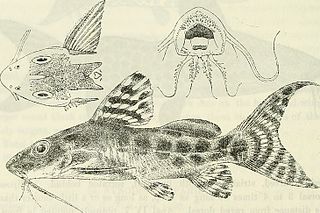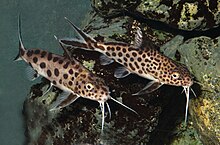Synodontis dhonti is a species of upside-down catfish endemic to the Democratic Republic of the Congo where it is only known from Lake Tanganyika. It was first described by Belgian-British zoologist George Albert Boulenger in 1917, based upon a single specimen collected from Lake Tanganyika at Kilewa Bay, in what is now the Democratic Republic of the Congo. The species is named after M.G. Dhont-De Bie, who accompanied the collector, Dr. L. Stappers, on his expedition. At one point, identified specimens Synodontis irsacae was believed to be juvenile individuals of S. dhonti and the two were considered to be the same species, but further research has identified differences between the two species and they are once again recognized as distinct from each other.

Synodontis granulosus is a species of upside-down catfish endemic to the Democratic Republic of the Congo, Burundi, Zambia, and Tanzania, where it is only known from Lake Tanganyika. It was first described by Belgian-British zoologist George Albert Boulenger in 1900, from specimens collected at multiple points along the shore of Lake Tanganyika. The species name comes from the Latin word "granulum", meaning of grain, and refers to the granular papillae present on the skin of the fish's body.
Synodontis polli, known as Poll's synodontis, is a species of upside-down catfish endemic to the Democratic Republic of the Congo, Burundi, Zambia, and Tanzania, where it is only known from Lake Tanganyika. It was first described by Belgian ichthyologist Jean-Pierre Gosse in 1982, from specimens collected at multiple points along the shore of Lake Tanganyika.

Synodontis petricola, known as the cuckoo catfish, or the pygmy leopard catfish, is a species of upside-down catfish endemic to Burundi, Zambia, the Democratic Republic of the Congo, and Tanzania where it is only known from Lake Tanganyika. It was first described by Belgian ichthyologist Hubert Matthes in 1959. The species name "petricola" is derived from a combination of the Latin petra, meaning stone or rock, and the Latin cola, meaning inhabitant. This refers to the rocky environment where this species is found.

Synodontis budgetti, known as Budgett's synodontis, is a species of upside-down catfish native to Benin, Cameroon, Central African Republic, Côte d'Ivoire, Mali, Niger, and Nigeria where it occurs in Lake Nokoue and the Niger. It was first described by Belgian-British zoologist George Albert Boulenger in 1911, from specimens collected in Lokoja, Nigeria. The species name budgetti comes from name of the collector of the original specimen, J.S. Budgett.

Synodontis caudalis, known as the filament tailed synodontis, or the whiptail synodontis, is a species of upside-down catfish native to the Democratic Republic of the Congo. It was first described by Belgian-British zoologist George Albert Boulenger in 1899, from specimens collected in what is now the Democratic Republic of the Congo. The species name caudalis comes from the Latin word cauda, meaning tail, and refers to the elongated filaments in the caudal fin of the species.

Synodontis filamentosus, known as the longfin synodontis, is a species of upside-down catfish that is native to the basins of the Nile, Volta and Niger Rivers as well as the Chad Basin. It was first described by British-Belgian zoologist George Albert Boulenger in 1901, from specimens obtained near the mouth of Lake No, on the White Nile in Sudan. The species name filamentosus comes from the elongated rays of the dorsal and caudal fins.
Synodontis ilebrevis is a species of upside-down catfish endemic to Zambia, where it is only known from Lake Tanganyika. It was first described by Jeremy John Wright and Lawrence M. Page in 2006, from specimens collected from Lake Tanganyika at Cape Chaitika, Zambia. The species name comes from the Latin word "ile", meaning intestine, and the Latin word "bevis", meaning short, and refers to the relatively short gut of this species.

Synodontis melanopterus is a species of upside-down catfish that is native to Benin, Niger and Nigeria where it is found at Porto Novo and in the Ouémé, Niger and Ogun River basins. It was first described by Belgian-British zoologist George Albert Boulenger in 1903, from specimens collected at Oguta, Nigeria, in the Niger River delta.

Synodontis nigromaculatus, known as the spotted squeaker, the blackspotted squeaker, or the speckled squeaker, is a species of upside-down catfish that is found widely in southern Africa. It has been identified in Angola, Botswana, the Democratic Republic of the Congo, Mozambique, Namibia, South Africa, Zambia, and Zimbabwe. It was first described by British-Belgian zoologist George Albert Boulenger in 1905, from specimens collected in Lake Bangweulu in Zambia.

Synodontis obesus, known as the Coas synodontis, is a species of upside-down catfish that is native to the coastal drainages of Cameroon, Ghana, Nigeria and Togo. It was first described by British-Belgian zoologist George Albert Boulenger in 1898. The species name obesus is derived from the Latin word obesus, meaning "fat".

Synodontis ocellifer, known as the ocellated synodontis, is a species of upside-down catfish native to the rivers of northern and western Africa. It has been reported in 10 countries, including Burkina Faso, Cameroon, Chad, Gambia, Ghana, Guinea, Mali, Niger, Nigeria, and Senegal. It was first described by Belgian-British zoologist George Albert Boulenger in 1900, from specimens collected in Kunchow Creek, in Gambia. The species name ocellifer comes from the Latin word ocellus, meaning "eye", and the Latin word ifer, meaning "to carry", which refers to the black spots, possibly with white centers found on the sides.

Synodontis ornatipinnis, known as the barfin synodontis, is a species of upside-down catfish that is native to the Congo Basin of the Democratic Republic of the Congo and Zambia. It was first described by British-Belgian zoologist George Albert Boulenger in 1899, from specimens collected in Mbandaka, on the Congo River in what is now the Democratic Republic of the Congo. The species name ornatipinnis means "ornate fins".

Synodontis resupinatus is a species of upside-down catfish that is native to the Niger basin and the Bénoué River of Cameroon, Mali, and Nigeria. It was first described by British-Belgian zoologist George Albert Boulenger in 1904, from specimens obtained near Lokoja, Nigeria.

Synodontis sorex is a species of upside-down catfish that is widely distributed in the rivers of northern Africa. It was first described by German zoologist Albert Günther in 1864, from specimens obtained in the upper Nile River, near Khartoum, Sudan. The species name sorex comes from the Latin word for shrew or shrew-mouse, the allusion was not explained. It possibly describes the pointed snout or the long, slender teeth.
Synodontis tanganyicae is a species of upside-down catfish endemic to the Democratic Republic of the Congo, Zambia, and Tanzania, where it is only known from Lake Tanganyika. It was first described by Russian-American ichthyologist Nikolai Andreyevich Borodin in 1936, from specimens collected at Kasaga, in what is now the Democratic Republic of the Congo. The species name tanganyicae comes from the habitat of the species, Lake Tanganyika.

Synodontis zambezensis, known as the brown squeaker, the korokoro, or the plain squeaker, is a species of upside-down catfish that is native to the middle and lower Zambezi River system of Eswatini, Mozambique, South Africa, Tanzania, Zambia and Zimbabwe. It was first described by German naturalist and explorer Wilhelm Peters in 1852, from specimens collected in the Zambezi River in Mozambique. The species name zambezensis is derived from the Zambezi River, where this species is found.
Synodontis lucipinnis is a species of upside-down catfish endemic to Zambia, where it is only known from the Musende Rocks area (Mpulungu) of Lake Tanganyika. It was first described by Jeremy John Wright and Lawrence M. Page in 2006. The species name "lucipinnis" is derived from a combination of the Latin luci, meaning bright or clear, and the Latin pinnis, meaning fin. This refers to the light coloration in a patch on the base of the fins of this species.

Synodontis melanostictus is a species of upside-down catfish endemic to Lake Tanganyika and its tributaries. It has been found in Zambia, the Democratic Republic of the Congo, and Burundi. It was first described by British-Belgian zoologist George Albert Boulenger in 1906, based upon a specimen from the Lofubu River. The species name "melanostictus" is derived from a combination of the Greek melano, meaning black, and the Greek stiktos, meaning punctured or spotted. This refers to the black spotted pattern that occurs on the body of this species.
Synodontis irsacae is a species of upside-down catfish endemic to Zambia, the Democratic Republic of the Congo, and Tanzania, where it is only known from Lake Tanganyika. It was first described by Belgian ichthyologist Hubert Matthes in 1959, from specimens collected from Lake Tanganyika at Kalundu, in what is now the Democratic Republic of the Congo. The species name " irsacae" is derived from the abbreviation "I.R.S.A.C.", or Institut pour la Recherche Scientifique en Afrique Centrale. For many years, specimens of the species were considered to be juvenile members of S. dhonti, but in 2006, J.J. Wright and L.M. Page identified unique characteristics of this species that established that they were a unique species.














